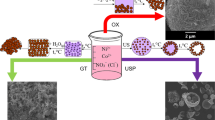Conclusions
The incorporation of spinel (5–10%) into the composition of the solid solution leads to periclase grain growth and to its sintering. Excess spinel in combinations with periclase over this quantity prevents recrystallization sintering of the specimens.
A reduction in the synthesis temperature of most the spinels from 1750 to 1450°C contributes the sintering of the compositions under investigation, and improves their technical properties.
In the periclase—spinel compositions the maximum influence on the grain growth and the properties of the specimens is exerted by the temperature conditions used for synthesizing the high-alumina spinels, while the conditions used to obtain the highly chromic spinels, and especially the magnesiochromite, have little or no effect on the technical properties of the fired product.
With an increase in the spinel phase concentration from 5 to 30%, and also when there is a change in its composition in the direction from magnesia-alumina spinel to magnesiochromite, such factors as strength, porosity, and spalling are impaired.
In the MgO-Mg(Al1−X, CrX)2O4 system it is possible to obtain strong, dense, and simultaneously spalling-resistant refractories by using small additions of alumina spinel, synthesized at low temperatures ensuring the completion of the spinel-forming reaction.
Similar content being viewed by others
Literature cited
A. S. Frenkel et al., Collection of Papers from UNIIO, Metallurgizdat, Vol. XLVIII. No. 1, 72 (1956).
A. P. Panarin, Ogneupory, No. 10, 447 (1964).
V. A. Bron, Ogneupory, No. 1, 44 (1966).
Ya. V. Klyucharov and S. A. Suvorov, Ogneupory, No. 1, 34 (1966).
E. V. Ivanov et al., Ogneupory, No. 1, 1 (1967).
G. V. Kukolev et al., Ogneupory, No. 8, 13 (1967).
A. I. Lyudvinskii et al., Ogneupory, No. 7, 9 (1967).
Yu Kuo-Ts'eng, Ogneupory, No. 2, 87 (1960).
M. I. Diesperova and J. A. Bron, Trudy VostIO, Metallurgiya, No. 5, 205, (1964).
A. Kielski, Zesk. nauk. akad. gbrnhuth, No. 200, 99 (1969).
J. Staron, Ber. Dtsch. Keram. Ges., 44, No. 8, 359 (1967).
A. M. Alper et al., J. Amer. Ceram. Soc., 47, No. 1, 30 (1964).
A. M. Alper et al., J. Amer. Ceram. Soc.,45, No. 6, 263 (1962).
Ya. V. Klyucharov, and S. A. Suvorov, Ogneupory, No. 5, 42 (1967).
Author information
Authors and Affiliations
Additional information
Translated from Ogneupory, No. 3, pp. 53–57, March, 1971.
Rights and permissions
About this article
Cite this article
Suvorov, S.A., Markova, L.F. Effect of composition, quantity, and synthesis temperature of spinels, and some properties of periclase — Spinel compositions. Refractories 12, 193–196 (1971). https://doi.org/10.1007/BF01284887
Issue Date:
DOI: https://doi.org/10.1007/BF01284887




